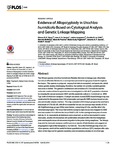Use este identificador para citar ou linkar para este item:
http://www.alice.cnptia.embrapa.br/alice/handle/doc/1057798| Título: | Evidence of Allopolyploidy in Urochloa humidicola based on cytological analysis and genetic linkage mapping. |
| Autoria: | VIGNA, B. B. Z.  SANTOS, J. C. S.   JUNGMANN, L.   VALLE, C. B. do   MOLLINARI, M.   PASTINA, M. M.   PAGLIARINI, M. S.   GARCIA, A. A. F.   SOUZA, A. P.   |
| Afiliação: | Bianca B. Z. Vigna, UNICAMP; Jean C. S. Santos, UNICAMP; LETICIA JUNGMANN CANCADO, CNPAE; CACILDA BORGES DO VALLE, CNPGC; Marcelo Mollinari, ESALQ; MARIA MARTA PASTINA, CNPMS; Maria Suely Pagliarini, Universidade Estadual de Maringá; Antonio A. F. Garcia, ESALQ; Anete P. Souza, UNICAMP. |
| Ano de publicação: | 2016 |
| Referência: | Plos One, San Francisco, v. 11, n. 4, p. 1-23, Apr. 2016. |
| Conteúdo: | The African species Urochloa humidicola (Rendle) Morrone & Zuloaga (syn. Brachiaria humidicola (Rendle) Schweick.) is an important perennial forage grass found throughout the tropics. This species is polyploid, ranging from tetra to nonaploid, and apomictic, which makes genetic studies challenging; therefore, the number of currently available genetic resources is limited. The genomic architecture and evolution of U. humidicola and the molecular markers linked to apomixis were investigated in a full-sib F1 population obtained by crossing the sexual accession H031 and the apomictic cultivar U. humidicola cv. BRS Tupi, both of which are hexaploid. A simple sequence repeat (SSR)-based linkage map was constructed for the species from 102 polymorphic and specific SSR markers based on simplex and double-simplex markers. The map consisted of 49 linkage groups (LGs) and had a total length of 1702.82 cM, with 89 microsatellite loci and an average map density of 10.6 cM. Eight homology groups (HGs) were formed, comprising 22 LGs, and the other LGs remained ungrouped. The locus that controls apospory (apo-locus) was mapped in LG02 and was located 19.4 cM from the locus Bh027.c.D2. In the cytological analyses of some hybrids, bi- to hexavalents at diakinesis were observed, as well as two nucleoli in some meiocytes, smaller chromosomes with preferential allocation within the first metaphase plate and asynchronous chromosome migration to the poles during anaphase. The linkage map and the meiocyte analyses confirm previous reports of hybridization and suggest an allopolyploid origin of the hexaploid U. humidicola. This is the first linkage map of an Urochloa species, and it will be useful for future quantitative trait locus (QTL) analysis after saturation of the map and for genome assembly and evolutionary studies in Urochloa spp. Moreover, the results of the apomixis mapping are consistent with previous reports and confirm the need for additional studies to search for a co-segregating marker. |
| Thesagro: | Gene Planta forrageira |
| Palavras-chave: | Mapeamento genético |
| Digital Object Identifier: | 10.1371/ journal.pone.0153764 |
| Tipo do material: | Artigo de periódico |
| Acesso: | openAccess |
| Aparece nas coleções: | Artigo em periódico indexado (CNPMS)  |
Arquivos associados a este item:
| Arquivo | Descrição | Tamanho | Formato | |
|---|---|---|---|---|
| Evidenceallopolyploidy.PDF | 2,85 MB | Adobe PDF |  Visualizar/Abrir |









